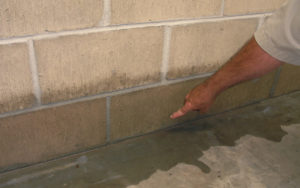The Ultimate Guide To Best Basement Waterproofing
The Ultimate Guide To Best Basement Waterproofing
Blog Article
Excitement About Best Basement Waterproofing
Table of ContentsBest Basement Waterproofing for Beginners7 Simple Techniques For Best Basement WaterproofingThe Only Guide to Best Basement WaterproofingSome Of Best Basement WaterproofingBest Basement Waterproofing Fundamentals Explained
uses excavation methods towards the base of the structure's foundation. includes getting rid of moisture after it has gone into the cellar. AdvantaClean's experienced experts and specialists will find the water resource. If wall surface or piece splits are present, we will infuse polyurethane and epoxies into the splits and seal the compromise, stopping further moisture from going into.If there's condensation on the outside of the aluminum foil, you have high humidity in your cellar. If the foil has condensation on the inside surface (following to the wall), the dirt around your house might be naturally damp from a high water table or bad dirt drain.
You can waterproof simply your interior wall surfaces, which might resolve the issue. Once they dry out, they adhere permanently to concrete and stonework wall surfaces.
Examine This Report about Best Basement Waterproofing
Concrete water resistant layers can not be used to previously painted surfaces; examine the tag. Understood as densifiers, they are appropriate only for walls that have not been repainted or secured.
You clean, roll, or spray it on a lot more heavily one gallon covers simply 75 square feet, not the 300 square feet common with conventional paint. Water resistant paint is fine for DIY application. You can use it over repainted surface areas, and paint over it once it's cured (one gallon prices $37).
It can set you back $10,000 to $15,000, relying on the work required. Outside waterproofing involves digging deep into around the residence fully depth of the structure walls, after that setting up a waterproof coating or membrane layer topped by water drainage panels. The panels supply an easy course for water to stream to an outside French drain at the end of your foundation.
A cellar without waterproofing is kind of like that. Your basement doesn't want to go with a rainstorm without correct protection just as much as you don't desire to.
Excitement About Best Basement Waterproofing
However if you have actually done your research study, you would certainly understand there are 2 kinds of waterproofing: exterior and interior. It can get confusing what they both mean, which one's a better investment, and what will actually keep the water out. Do not stress, we created this blog site to quickly define both methods for you and discuss the pros and cons of each.
Exterior waterproofing is a waterproofing approach that includes sealing your home from the outside. It's kind of like a moat around a castle. It involves excavating a trench around your whole home down to the structure (regarding 8 to 10 feet down). The structure wall surfaces are after that cleansed, secured, and read the full info here covered with a water-proof membrane layer or sealer.

How Best Basement Waterproofing can Save You Time, Stress, and Money.
It's a more involved process that needs excavating up your backyard, which is expensive and time-consuming. Exterior waterproofing includes getting rid of every little thing surrounding your house, consisting of verandas, driveways, sidewalks, landscape design, AC systems, decks, and so forth. If any one of the job was done inaccurately and water is still entering your cellar, there isn't much you can do to correct or fix it.
Interior basement waterproofing entails waterproofing from the inside. Any kind of water that leaks right into your cellar is redirected prior to it touches your flooring. It's kind of like putting on a raincoat under your clothes. It includes two points: a water drainage track and a sump pump. It works by sealing the within your basement walls and floors so water that tries to enter is funnelled out via a sump pump.
It's an effective method to water resistant your cellar - Best Basement Waterproofing. The disadvantage of interior basement waterproofing mostly involves the installation process. This method needs kept products, furnishings, and integrated shelving or closets to be relocated from touching the Visit Your URL cellar wall surfaces. And throughout installment, your cellar can not be made use of. The biggest difference between the two methods is this: Exterior waterproofing is a preventative solution and interior waterproofing is a restorative solution.
The Of Best Basement Waterproofing
In conclusion, outside and indoor basement waterproofing are both reliable techniques of safeguarding your home from water damages. Exterior waterproofing creates an obstacle that avoids water from entering your home, while interior waterproofing reroutes water that does enter your home. And it's essential to note that outside waterproofing is an expensive and turbulent setup process when contrasted to interior waterproofing.
Whichever method you select, make certain you pick a reputable and reliable contractor for the task. If you have any kind of questions regarding cellar waterproofing, please reach out to us.
You can fill up out our form right here, begin a conversation in the bottom right-hand corner, or call us at 1-800-827-0702.
Report this page